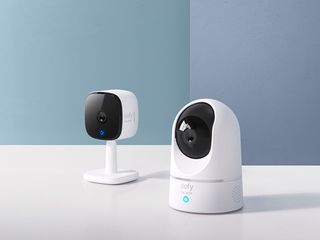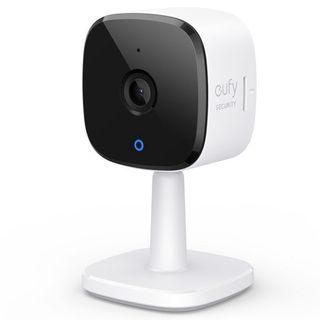Eufy Security 2K Indoor Cam vs. 2K Indoor Cam Pan & Tilt: Which should you buy?

Eufy Security 2K Indoor Cam Pan & Tilt

At an only slightly higher list price, the Pan & Tilt edition of the Eufy Indoor Cam adds 360 degrees of horizontal movement and 96 degrees of vertical, greatly expanding its coverage and effectiveness. This model competes well against other comparable units from Wyze, Nest, and Ring.
Eufy Security 2K Indoor Cam Pan & Tilt
Don't miss a thing
Eufy Security 2K Indoor Cam

The standard variant of the Eufy Indoor Cam has the same software, voice assistant support, video quality, AI tech, and storage options as its more expensive counterpart. Its 125-degree field of view (FOV) will be enough for many buyers, especially if it's guarding a narrow spot like an entryway, but this limits its ability to cover more rooms or potential blind spots.
Eufy Security 2K Indoor Cam
Solid but static
Aside from the obvious physical differences between a fixed camera and one that can pivot, both of Eufy's Indoor 2K cameras have virtually identical specs and similarly-affordable price points. Either purchase will get you 2K footage with an excellent FOV, microSD + cloud storage, AI categorization, and voice assistant integration, among other excellent features for a bargain camera. While you can't go wrong with either camera, this piece should help you decide whether the Pan & Tilt upgrade fits your needs.
Indoor Cam vs. 2K Indoor Cam Pan & Tilt: What's the difference?
The primary benefit of the Pan & Tilt version is the ability to track moving people or objects, ensuring that nothing can hide in your camera's blind spot. Using the Eufy app, you can toggle the option to have the camera follow any moving objects, or to only follow people so it isn't distracted by cars or pets. You can also manually move the camera using the app, should you want to check something while you're away from home.
Panning and tilting aside, both cameras give you the exact same video quality and features.
There isn't much downside to having your camera protect more of your home. iMore reviewer Christopher Close noted that the rotating mechanism is virtually silent, which ensures it can keep track of scampering children or animals without adding another source of noise. He did observe that the camera has trouble keeping up with fast-moving people, but the stationary Eufy would lose track of them that much faster.
It's also fair to say that moving camera footage may appear slightly blurrier than stationary footage — the tradeoff for covering more ground.
| Header Cell - Column 0 | Eufy Security 2K Indoor Cam | Eufy Security 2K Indoor Cam Pan & Tilt |
|---|---|---|
| Dimensions | 2.17in x 2.17in x 4.09in | 2.95in x 2.95in x 4.25in |
| Weight | 98g | 217g |
| Pan range | N/A | 360 degrees |
| Tilt range | N/A | 96 degrees |
| Voice Assistant / Smart Home support | Alexa, Google Assistant, Apple HomeKit | Alexa, Google Assistant, Apple HomeKit |
| Resolution | 2K | 2K |
| Field of View | 125 degrees | 125 degrees |
| Image Sensor | 1/2.7" CMOS | 1/2.7" CMOS |
| Digital Zoom | 8X | 8X |
| FPS | 15 | 15 |
| Night Vision Range | 32.8 feet | 32.8 feet |
| Local storage | Up to 128GB MicroSD (not included) | Up to 128GB MicroSD (not included) |
| Cloud storage | Yes | Yes |
| Audio | 2-Way | 2-Way |
One major privacy benefit of the Pan & Tilt model is an automatic function that turns the camera inward to face its container whenever you turn it off. That way, you can look and see a visual indication that you're not currently being recorded. If you plan to have your cameras on at all times anyway, even when home, then this feature will be less important to you; but those with security concerns can rest a bit easier.
Be an expert in 5 minutes
Get the latest news from Android Central, your trusted companion in the world of Android
Any other differences are fairly minor. The Pan & Tilt model weighs more and is more bottom-heavy, which may make it less likely to get accidentally toppled over than its counterpart. Either model can be mounted using the included mounting plate, but for the Pan & Tilt model to be mounted upright, you'll need to buy a separate accessory from Eufy.
Pan & Tilt is worth paying extra
The increased FOV that panning and tilting provide more than justifies the minor increase in price.
The upgraded, movable model frees you from the anxiety of finding the perfect angle to place your camera. This forestalls any unnecessary anxiety about criminals lurking just out of sight, and gives you more options on where to place your camera where kids or pets won't topple it over. Plus, by automatically blocking its feed when it turns off, this model offers you, or any guests, an obvious indication that no one is secretly being recorded.
Considering the minor price difference between the two, these benefits certainly justify paying for the superior model. The exception may be buyers who only want to focus their surveillance on one specific spot, such as the front door, making panning unnecessary.
But to make the most of your purchase and keep watch on as much of your home as possible, we still recommend you go with the Pan & Tilt model. Especially if you plan to buy multiple units to cover your entire house, which will let you buy fewer cameras in total.

More visual range and privacy
Along with everything unlocked in the base model, the Pan & Tilt model can automatically or manually move to keep track of moving objects and better monitor your motion zones. With a sleek design, a privacy mode, and good capture performance on the move, this camera is still a bargain.

Excellent video quality, features, and security app
For covering one specific part of your house, this Eufy model offers everything you need. Voice assistant controls, two-way audio, AI-based responses to different people or objects, either local or cloud storage and, of course, 2K video are all impressive features considering the entry-level price. Just make sure you keep it indoors and set it up at the right angle.

Michael is Android Central's resident expert on fitness tech and wearables, with an enthusiast's love of VR tech on the side. After years freelancing for Techradar, Wareable, Windows Central, Digital Trends, and other sites on a variety of tech topics, AC has given him the chance to really dive into the topics he's passionate about. He's also a semi-reformed Apple-to-Android user who loves D&D, Star Wars, and Lord of the Rings.
For wearables, Michael has tested dozens of smartwatches from Garmin, Fitbit, Samsung, Apple, COROS, Polar, Amazfit, and other brands, and will always focus on recommending the best product over the best brand. He's also completed marathons like NYC, SF, Marine Corps, Big Sur, and California International — though he's still trying to break that 4-hour barrier.
